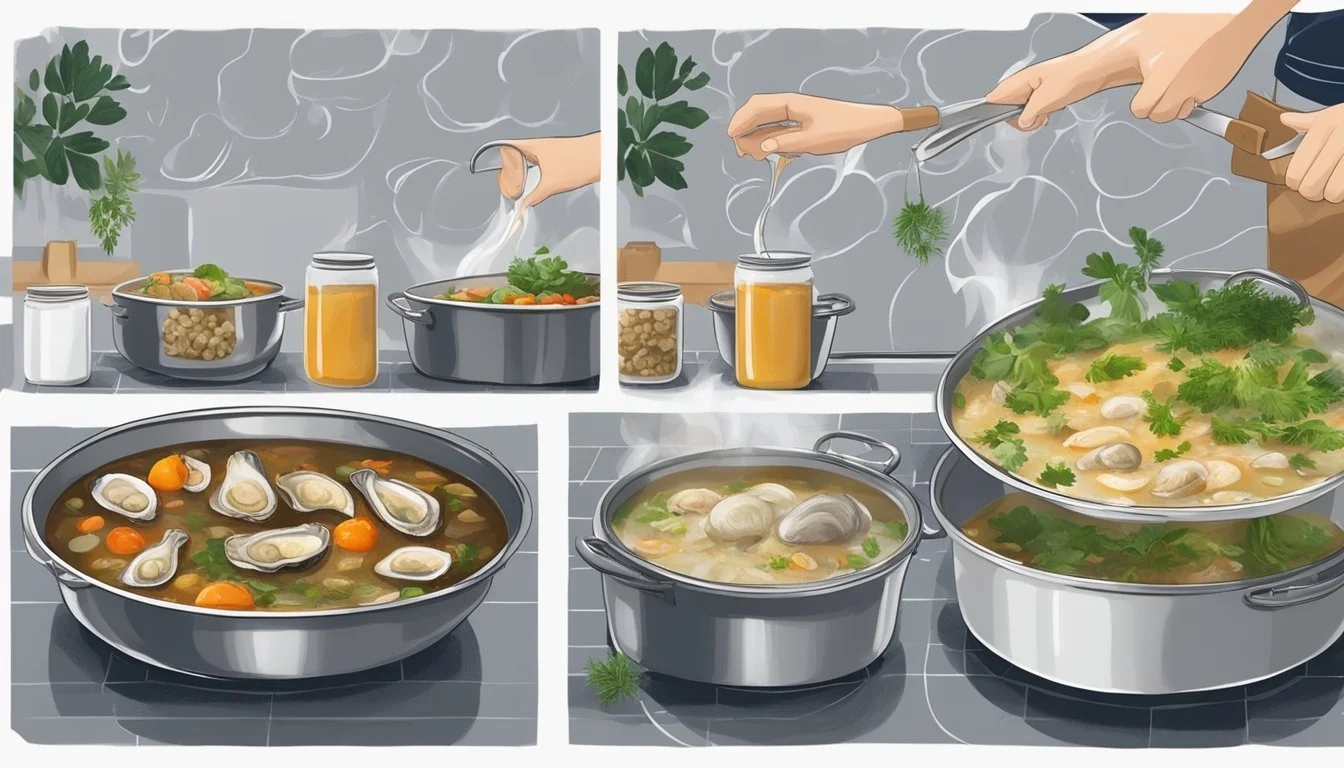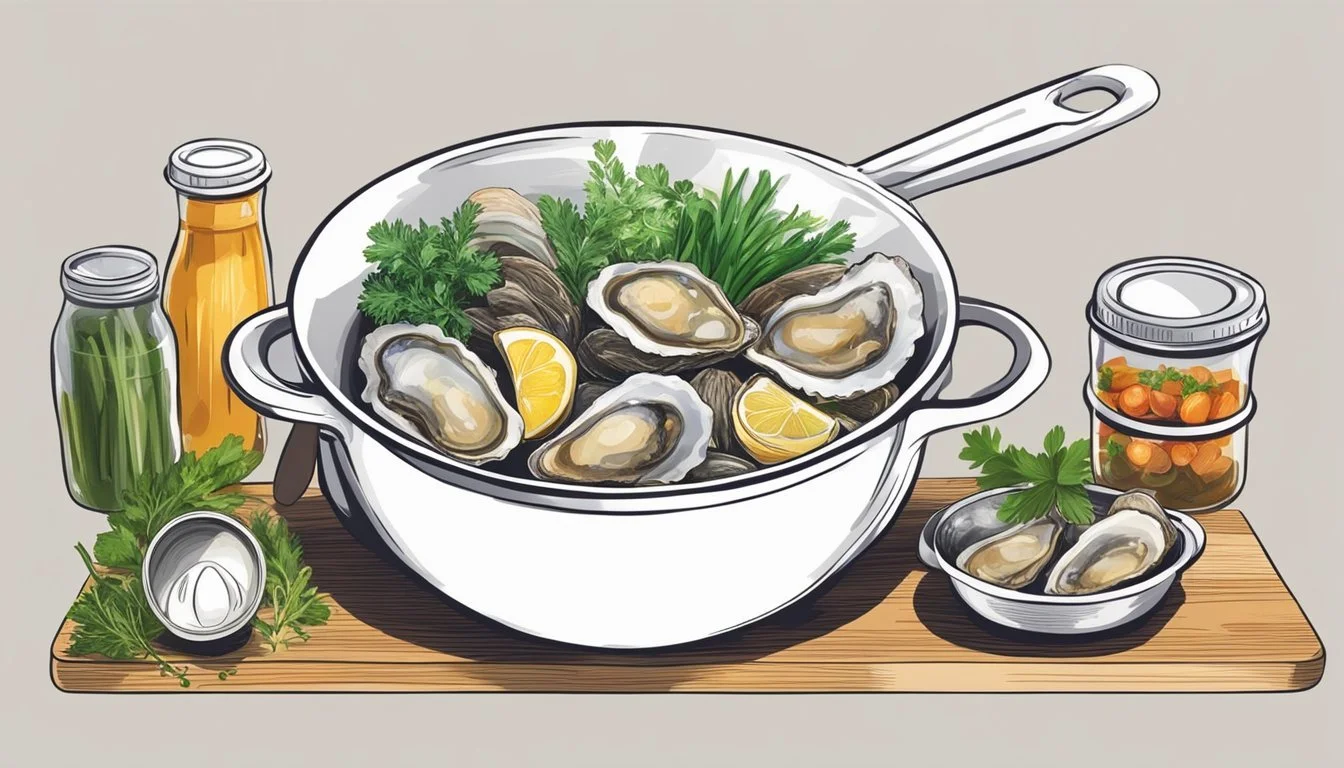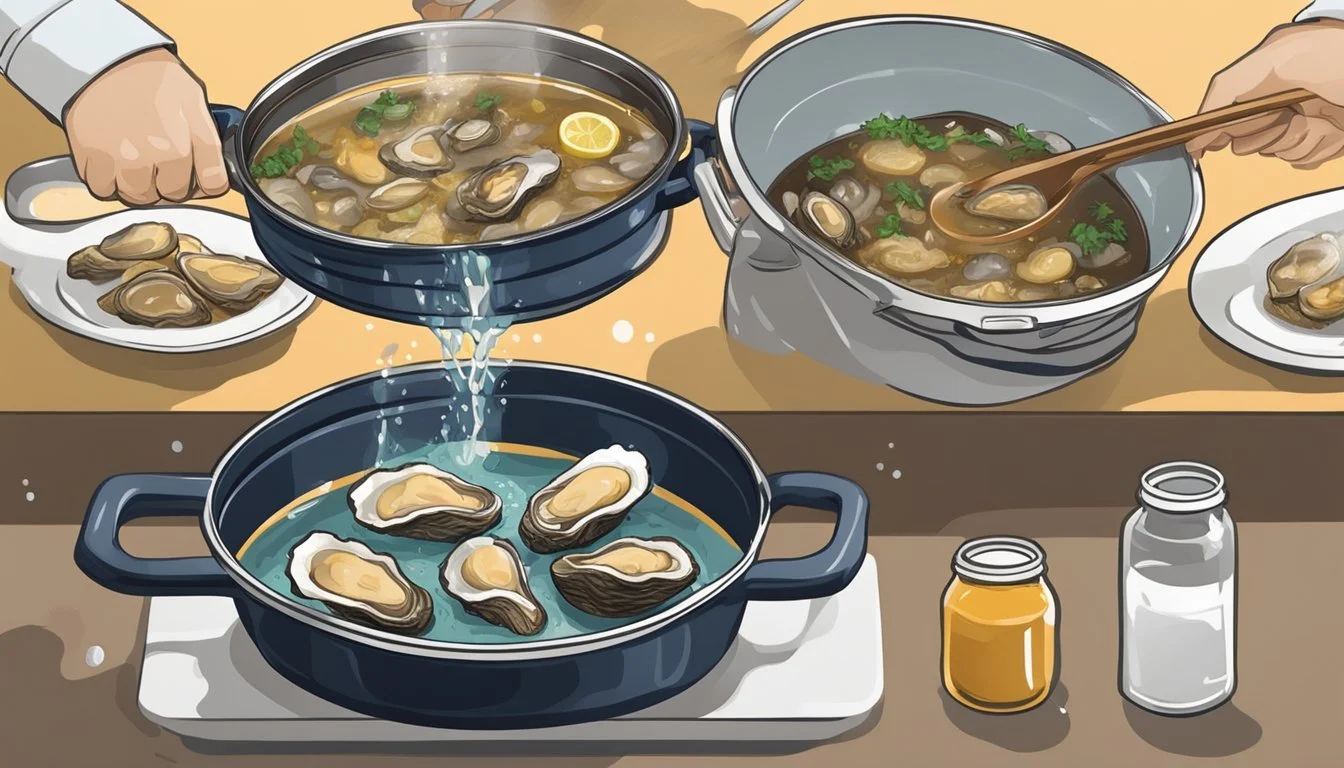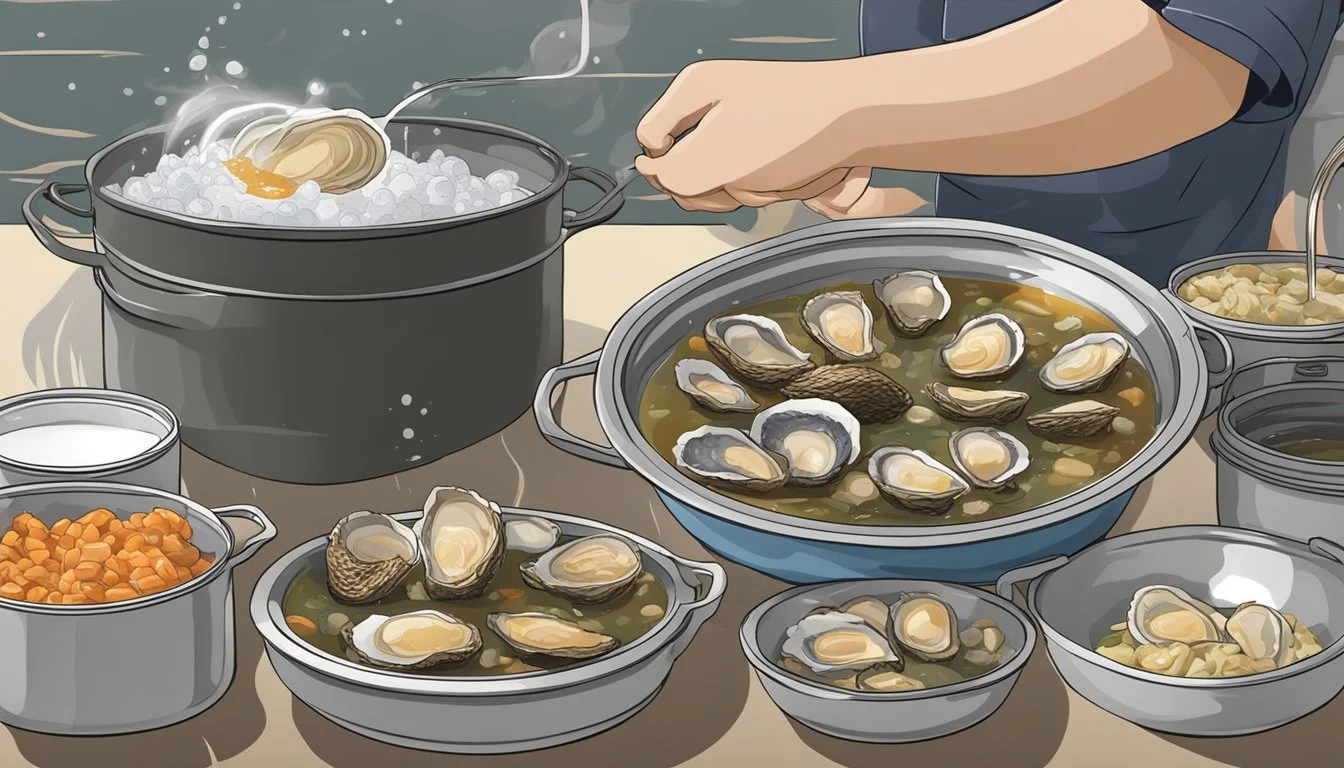Fixing Overly Salty Canned Oysters
Techniques for Perfectly Seasoned Stews
Canned oysters are a convenient and flavorful addition to many dishes, offering a taste of the sea in a preserved form that can be enjoyed year-round. However, preservatives and the canning process can sometimes lead to a higher level of saltiness in the oysters (What wine goes well with oysters?), which may overpower their naturally delicate, briny flavor. Excess saltiness can also disrupt the balance of flavors in stews and other oyster-based preparations, making it essential to find ways to correct the seasoning issue.
Rinsing canned oysters is a simple yet effective initial step in reducing their salt content. Rinsing under cold water can wash away some of the superficial salt without compromising the oysters' texture. For a more in-depth approach, soaking the oysters in a vinegar mixture before rinsing has been proposed as a means to mellow out the brininess while enhancing their inherent flavors. This pre-preparation step sets the stage for the oysters to be seamlessly incorporated into stews.
Once the canned oysters have been adequately prepared, achieving the right balance of flavors in the stew is crucial. Culinary experts, like those contributing to MasterClass, emphasize the art of balancing flavors to counteract excessive saltiness. Adding ingredients that complement the oysters' natural flavors, such as aromatic vegetables, acid from tomatoes or wine, and fresh herbs, can create a harmonious taste profile. These strategies not only ensure that the central ingredient of the stew—the oyster—is tasted in its best form, but they also play a preventive role in maintaining the proper flavor equilibrium in seafood stews.
Understanding the Impact of Salt in Canned Oysters
Canned oysters often come with a high salt content, which is a critical factor in both their preservation and flavor profile. This section examines that salt's role and its impact on the culinary uses of canned oysters.
Conservation: Salt acts as a preservative, extending the shelf life of oysters by inhibiting bacterial growth. While essential for storage, it can dominate the flavor of the oysters once opened.
Flavor Balance: Canned oysters can arrive in various forms, including in brine or smoked. Smoked oysters are particularly known for a complex flavor profile, with the smoking process imparting a distinct taste that complements the natural saltiness.
Brined Oysters: These typically contain a solution of water and salt, which can lead to a high salt content in the oysters.
Smoked Oysters: These usually have a bold taste as the smoking process adds another layer of flavor. However, the process again often introduces additional salt.
Eatery experts recognize that the saltiness of canned oysters not only impacts their taste but can also affect the overall flavor of dishes if not addressed. For stew preparations, chefs may suggest ridding the oysters of excess salt to ensure a harmonious melding of flavors.
Rinsing Practice: A recommended step is to rinse canned oysters under cold water. This action helps remove some surface salt, but care must be taken to avoid washing away desirable flavors.
When utilizing canned oysters in stews or other recipes, individuals must assess the oyster's salt content. It is imperative to balance the existing saltiness against other ingredients to avoid an overly saline dish, while still preserving the oyster's distinct taste.
Initial Steps to Fix Over-Salted Oysters
When dealing with over-salted canned oysters, the initial steps involve reducing the excess salt through effective rinsing and soaking techniques. These foundation methods help in preparing the oysters for further flavor balancing in stews or other dishes.
Rinsing Technique
Rinsing over-salted oysters with water is the primary step in attempting to desalinate them. One should:
Drain the oysters from their brine.
Place the oysters in a colander.
Run cold water over the oysters for a few minutes, stirring gently to ensure all oysters get thoroughly rinsed.
This rinsing process helps wash away some of the surface salt, which can be excessive in canned oysters. It's important to do this gently to maintain the oysters' integrity.
Soaking Oysters
Following the rinse, a soaking process can help draw out more salt from the oysters. The oysters should be:
Soaked in a bowl of fresh cold water for about 30 minutes.
The water can be changed once or twice during this process, especially if it becomes too salty.
Soaking can further help in mitigating the salty taste by allowing osmosis to draw some of the salt out from the oysters' flesh into the surrounding water. After soaking, it's advisable to discard the used water and give the oysters another quick rinse before adding them to dishes.
Balancing Flavors in Stews and Soups
When a stew or soup is too salty, one can correct the flavor balance by employing specific adjustments that involve dilution and the addition of complementary ingredients.
Diluting the Dish
One can alleviate the salinity in stews and soups (What wine goes well with soups?) by diluting the overall flavor concentration. Gradually adding unsalted broth or water allows control over the taste. It is crucial to introduce the liquid slowly and to taste the dish continuously, ensuring that the dilution does not overly diminish the soup's or stew's intended flavors.
Adding Acidic Ingredients
Acidic ingredients can counteract excessive saltiness by providing a contrasting flavor profile. Lemon juice or vinegar can be beneficial. One should add these components sparingly and test the stew or soup frequently to achieve a harmonious flavor balance.
Incorporating Unsalted Ingredients
To offset an overly salty taste, incorporating unsalted ingredients such as additional vegetables, grains, or meats, which also add nutrients and texture, can be highly effective. They absorb some of the salt and contribute to a more balanced dish.
Working with Cream and Dairy
Cream and dairy have a mellowing effect on the intense salt flavor. Stirring in a small amount of milk, cream cheese, or dairy can soften the saltiness while also adding a rich and creamy consistency to the dish. These dairy additions should be unsalted or low in sodium to ensure they effectively reduce the perceived saltiness.
Improving Taste with Additional Components
To mitigate the saltiness of canned oysters, incorporating select starches, sweetening agents, and aromatic herbs and spices can effectively balance and enhance the overall flavor profile of stews.
Utilizing Starches
Inclusion of starches like rice, pasta, or a sprinkle of cornstarch can thicken stews and help absorb excess salt. Here is how one can use these starches effectively:
Rice: A versatile and absorbent grain, can subtly dilute overpowering saltiness.
Pasta: Works similarly to rice by increasing the volume and distributing the flavors.
Bread: Cubes of bread, when added, can soak up salty broth and can be removed before serving.
Cornstarch: Mixed with water, it thickens the liquid, which can lessen the perception of salt.
Infusing Sweetness
Balancing saltiness with sweetness can be achieved through cautious incorporation of natural sweeteners:
Honey or maple syrup: These natural sweeteners add a rich, complex flavor.
Granulated sugar or brown sugar: A pinch can neutralize the high salt content without making the dish overly sweet.
Using sweeteners should be done sparingly, as too much can shift the flavor balance too far from savory to sweet.
Enhancing with Herbs and Spices
Herbs and spices introduce aromatic notes and counteract saltiness with depth and complexity:
Fresh herbs like parsley or thyme provide a fresh, bright counterpoint to the briny oysters.
Spices such as black pepper or a dash of paprika can add zest and distract from the salt content.
By carefully selecting vegetables like celery and onion, chefs can incorporate more layers of flavor, contributing to a more harmonious dish.
Alternative Methods to Counteract Saltiness
When dealing with overly salty canned oysters, one must think beyond dilution. This section focuses on fats and citrus as effective agents to counterbalance excessive saltiness in dishes.
Applying Fats and Oils
Fats have the capacity to round out and absorb strong flavors. A well-known kitchen staple such as butter can be added to a stew with salty oysters to mitigate the intensity of the salt. The creaminess of butter envelops the salinity, dispersing its impact across the dish without overshadowing other flavors. Alternatively, a drizzle of olive oil or cream can serve a similar purpose, working seamlessly to soften the salt's sharpness.
Squeeze of Citrus
The addition of citrus, like lime juice, introduces a fresh and zesty element to dishes, which can neutralize salt to an extent. A squeeze of lime or lemon over the top of a finished stew subtly brightens the profile and distracts the palate from the saltiness. Plus, the natural acidity of citrus fruits helps to break down and balance flavors. Use citrus judiciously; the goal is to complement the dish, not to overshadow it with a new dominant flavor.
Advanced Tips: Easy Fixes and Flavor Pairings
Achieving the perfect balance in a stew with overly salty canned oysters requires a nuanced approach to flavor correction. The following strategies utilize everyday kitchen ingredients to mitigate excess salt and enhance the dish's overall palate.
Using Potatoes and Bread to Absorb Excess Salt
A stew suffering from excess saltiness can benefit from the addition of potatoes. Slicing a potato and letting it simmer within the stew allows it to absorb some of the salt. Similarly, a piece of bread can be used to soak up the salt from the liquid; however, one must remember to remove them before they become too soft and disintegrate into the dish.
Leveraging Vinegars and Sweeteners
Incorporating vinegars and sweeteners provides a simple yet effective method for counteracting saltiness. Small amounts of balsamic vinegar, rice vinegar, or white wine vinegar can introduce a desirable acidic note, while sweeteners like sugar or honey offset the salty dominance. The key is moderation, with tasting as one goes to find the perfect equilibrium.
Vinegars: Add a teaspoon at a time, taste, and adjust.
Balsamic Vinegar
Rice Vinegar
White Wine Vinegar
Sweeteners: Stir in sparingly and taste for balance.
Sugar
Honey
Mastering the Squeeze Technique
For creamier stews, the 'squeeze technique' can introduce a refreshing twist. A gentle squeeze of citric juice such as lemon or lime can bring forth brightness and counterbalance saltiness. A dollop of sour cream or heavy cream can also round out robust flavors and mellow the dish. It's essential to add these ingredients slowly and to continually taste the stew to achieve the desired taste profile without overpowering it.
Citric Squeeze: A careful squeeze to introduce zest without overwhelming.
Cream Additions: Sour cream or heavy cream for richness and flavor correction.
The Art of Prevention: Avoiding Over-Salting
Prevention is a crucial step when working with ingredients like canned oysters, which may already contain salt. To safeguard against over-salting, one should adopt precise techniques and develop an understanding of salt's impact on flavor.
Taste As You Go
Tasting food regularly during preparation is essential to achieving the desired flavor profile. One should start with a small amount of salt, then taste and adjust accordingly. This practice helps to avoid the irreversible step of adding too much salt. It's particularly important when dealing with pre-salted items like canned oysters. With each addition of seasoning, a careful assessment ensures flavors are balanced without tipping into over-salting.
Understanding Salt Varieties
Salt comes in numerous forms and each varies in flavor intensity and saltiness:
Table Salt: Finely ground and generally salty; it dissolves quickly, which can make it easy to overdo.
Kosher Salt: Coarser and less salty per volume than table salt, making it a favorite for careful seasoning.
It's advisable to select salt based on the dish one is preparing. For instance, kosher salt is often preferred for its ability to provide a more controlled and even seasoning, which is helpful in preventing over-salted stews. When seasoning, chefs must account for the size and shape of the salt crystals, as this will affect how much should be used to achieve the desired taste without over-salting the dish.
Conclusion
When one encounters overly salty canned oysters, they have at their disposal a variety of remedial steps. Rinsing the oysters under cold water is an immediate and effective measure to reduce the salt content; this can prevent the potential harm of excessive sodium intake.
For culinary aficionados seeking to balance flavors in stews, incorporate acidic ingredients like vinegar or lemon juice. These not only counteract saltiness but also enhance the dish's overall profile. Likewise, the introduction of herbs and unsalted stock can further diffuse the saltiness and introduce new flavors.
Cooking methods also play a crucial role in dealing with oversalted oysters. For instance, sautéing with aromatic vegetables or incorporating in casseroles can distribute the salt more evenly throughout the dish, mitigating the impact of the initial excess salt.
When adopting these measures, remember:
Precision: Add corrective ingredients gradually to avoid overpowering the dish.
Tasting: Regularly taste the dish to ensure the desired flavor balance is achieved.
By applying these fixes thoughtfully, the end result will be a rich, nuanced, and properly seasoned dish that highlights the delicate taste of oysters without the overpowering presence of salt.






